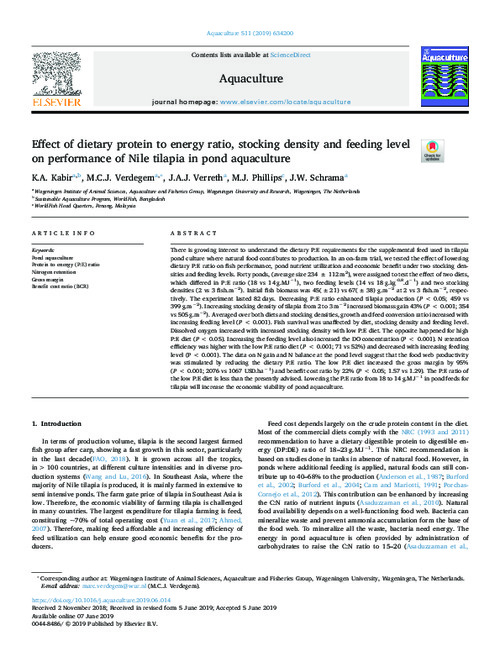Please use this identifier to cite or link to this item:
http://hdl.handle.net/20.500.12348/3625
Effect of dietary protein to energy ratio, stocking density and feeding level on performance of Nile tilapia in pond aquaculture

Abstract
- There is growing interest to understand the dietary P:E requirements for the supplemental feed used in tilapia pond culture where natural food contributes to production. In an on-farm trial, we tested the effect of lowering dietary P:E ratio on fish performance, pond nutrient utilization and economic benefit under two stocking densities and feeding levels. Forty ponds, (average size 234 ± 112 m2), were assigned to test the effect of two diets, which differed in P:E ratio (18 vs 14 g.MJ−1), two feeding levels (14 vs 18 g.kg-0.8.d−1) and two stocking densities (2 vs 3 fish.m−2). Initial fish biomass was 45(±21) vs 67(±38) g.m−2 at 2 vs 3 fish.m−2, respectively. The experiment lasted 82 days. Decreasing P:E ratio enhanced tilapia production (P < 0.05; 459 vs 399 g.m−2). Increasing stocking density of tilapia from 2 to 3 m−2 increased biomass gain 43% (P < 0.001; 354 vs 505 g.m−2). Averaged over both diets and stocking densities, growth and feed conversion ratio increased with increasing feeding level (P < 0.001). Fish survival was unaffected by diet, stocking density and feeding level. Dissolved oxygen increased with increased stocking density with low P:E diet. The opposite happened for high P:E diet (P < 0.05). Increasing the feeding level also increased the DO concentration (P < 0.001). N retention efficiency was higher with the low P:E ratio diet (P < 0.001; 71 vs 52%) and decreased with increasing feeding level (P < 0.001). The data on N gain and N balance at the pond level suggest that the food web productivity was stimulated by reducing the dietary P:E ratio. The low P:E diet increased the gross margin by 95% (P < 0.001; 2076 vs 1067 USD.ha−1) and benefit cost ratio by 22% (P < 0.05; 1.57 vs 1.29). The P:E ratio of the low P:E diet is less than the presently advised. Lowering the P:E ratio from 18 to 14 g.MJ−1 in pond feeds for tilapia will increase the economic viability of pond aquaculture.
- External link to download this item: https://dx.doi.org/10.1016/j.aquaculture.2019.06.014
Collections
- Sustainable aquaculture [2738]
View/
Author
-
Kabir, K.
-
Verdegem, M.
-
Verreth, J.
-
Phillips, M.
-
Schrama, J.W.
Author(s) ORCID(s)
- Marc Verdegemhttps://orcid.org/0000-0002-2058-3894
- Johan Verrethhttps://orcid.org/0000-0001-7277-5129
- Michael John Phillipshttps://orcid.org/0000-0002-0282-0286
AGROVOC Keywords
Type
- Journal Article
Publisher
- Elsevier (12 months)
